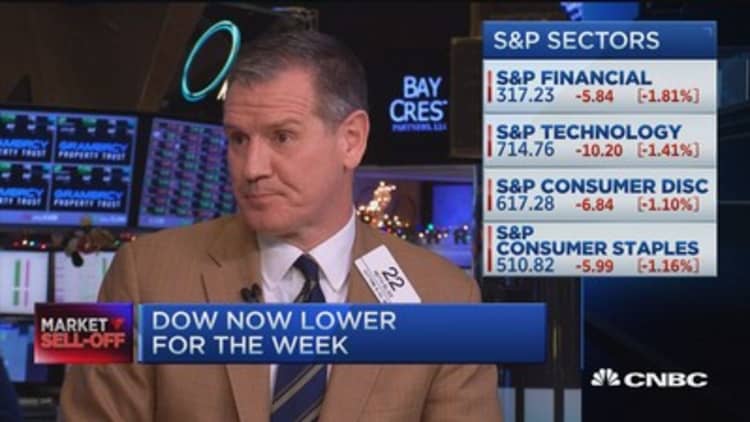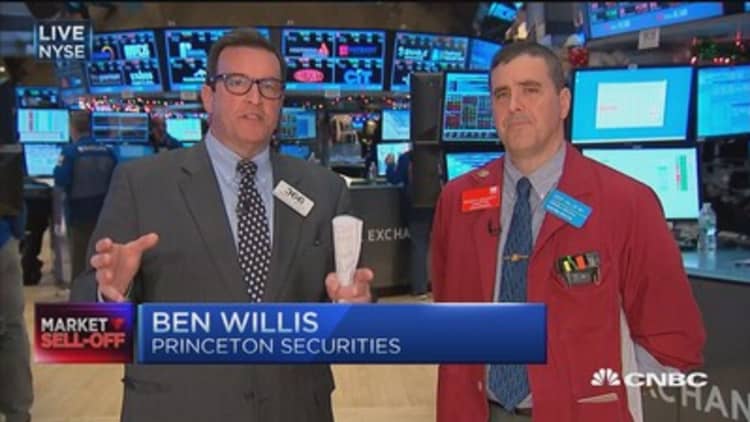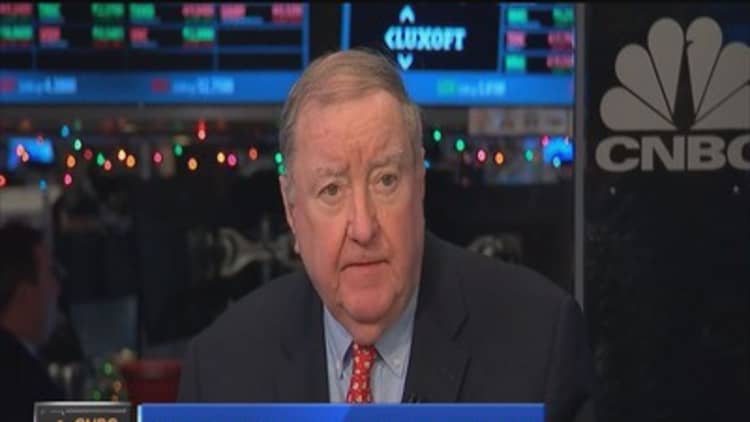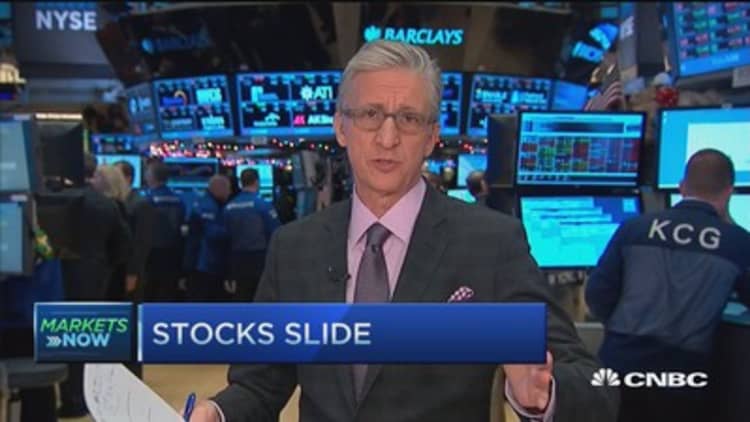





U.S. stocks closed sharply lower Friday as investors weighed low oil and economic data in the aftermath of the Federal Reserve's rate hike Wednesday. Options expiration also contributed to volatility. (Tweet This)
With Friday's late afternoon decline in stocks, the major U.S. averages wiped out gains for the week. Trade volume Friday was the second-highest of the year.
"In the context of the Fed we've removed some uncertainty. There's still some uncertainty about earnings going forward and you're experiencing that with some volatility in market pricing," said Timothy Hopper, chief economist at TIAA-CREF.
The Dow Jones industrial average had its worst day since Sept. 1, closing nearly 370 points lower as selling accelerated into the close. Nearly all constituents declined, with Boeing and Goldman Sachs contributing the most to losses. Disney turned lower to end the day off nearly 4 percent after BTIG downgraded the stock to "sell" from "neutral."
Read MoreWhy stocks are down today
The S&P 500 fell more than 1.5 percent, with financials plunging 2.5 percent to lead all sectors lower.
The Nasdaq composite declined about 1.6 percent to close below the psychologically key 5,000 level. Apple ended about 2.8 percent lower.
"You can't dismiss the quadruple witching. It begins to affect market volatility and volume. You also have a backdrop for the market that has not been as healthy as you want to see it," said Quincy Krosby, market strategist at Prudential Financial.
"The market basically has been going back, reverting to where it was before (the Fed)," she said. Low "oil prices has been difficult for the market to accept."
U.S. crude oil futures for January delivery, which expire Monday, settled down 22 cents, or 0.6 percent at $34.73 a barrel for a 2.5 percent decline for the week.
The February contract settled down 21 cents at $36.06 a barrel. Baker Hughes said oil rigs rose by 17, after four straight weeks of decline.
The Dow transports ended more than 2 percent lower after hitting a fresh 52-week low in intraday trade.
Year-to-date performance
Analysts also noted some pressure from a decline in the flash Markit U.S. Services PMI for December. The figure showed 53.7, down from the final November read of 56.1 and the lowest print in 12 months.
"I think the fear is (the Fed) is starting to tighten in an economy that's starting to weaken," said Ben Pace, chief investment officer at HPM Partners.
He also said there was some disappointment around the level of stimulus measures from the Bank of Japan overnight, which included purchases of exchange-traded funds and extension of the maturity of bonds it owns. Analysts said, however, that the move was minor and did not amount to a significant change to the bank's stimulus.
Read MoreThis could be what drives stocks next year
The U.S. dollar declined more than half a percent against major world currencies, with the euro near $1.087 and the yen at 121.29 yen against the greenback in the close.
The Nikkei 225 ended down nearly 2 percent after a volatile reaction to the Bank of Japan decision. The STOXX Europe 600 closed about 1 percent lower as oil weighed.
U.S. Treasury yields edged lower, with the at 0.95 percent and the 10-year yield at 2.20 percent.
"I think there's disappointment the so-called dots were not revised downwards," said Gregory Peters, senior portfolio manager at Prudential Fixed Income. "The rest is just very thin volumes and flows. I think directionally people are worried about the year-end rally and hedging themselves."
Richmond Fed President Jeffrey Lacker said Friday the Fed forecasts, or so-called dot-plot, pointing to four interest rate hikes in 2016 show what the U.S. central bank means when it says it anticipates raising rates at a "gradual pace," according to a Reuters report.
He also said the Fed rate hike shows how much the U.S. economy has improved. He added the divergence of central bank policies is not necessarily a matter of concern.
Lacker was a voting member of the Federal Open Market Committee this year but will not be in 2016.
"I think all of this is just options-related. The decline I don't think is very significant, especially if we continue to see an upward move in oil prices," said Peter Cardillo, chief market economist at First Standard Financial.
"I don't think it's significant in the sense it's the beginning of a new trend," he said.
The third Friday of every March, June, September, and December is quadruple "witching," the expiration of three related classes of options and futures contracts, along with individual stock futures options.
"Options expiration typically involves more volume but you actually see more of the selling the Wednesday or Thursday ahead of the expiration. Oftentimes you will have a little volatility (the day of) but not always more selling. I think the selling is due to low oil prices (this morning)," said Randy Frederick, managing director of trading and derivatives.
"The December (expiration) is typically the biggest expiration," he said.
Read MoreFriday is witching day for stocks
U.S. stocks closed near session lows Thursday, breaking a three-day win streak with losses of more than 1 percent each as investors eyed oil prices and economic data, after the Federal Reserve on Wednesday made the widely expected move of raising rates.
"Intraday oversold conditions are likely to give way to improved short-term momentum," BTIG Chief Technical Strategist Katie Stockton said in a morning note. "Sentiment seems too bearish ahead of a possible Santa Claus rally, which is a seasonal phenomenon that calls for a seven-day rally beginning on Christmas Eve this year. Since 2000, the SPX has averaged a gain of 1.2 percent over this period."
Major U.S. Indexes
The Dow Jones industrial average closed down 367.39 points, or 2.1 percent, at 17,128.45, with Boeing leading decliners and Caterpillar the only gainer.
The index closed down 0.79 percent for the week, with DuPont the worst decliner and Exxon Mobil and Chevron the top performers for the week.
The closed down 36.34 points, or 1.78 percent, at 2,005.55, with financials leading all 10 sectors lower.
The S&P ended the week down 0.34 percent, with materials the worst performer and utilities the best.
The Nasdaq composite closed down 79.47 points, or 1.59 percent, at 4,923.08.
The Nasdaq lost 0.21 percent for the week. Apple declined 6.3 percent for the week, while the iShares Nasdaq Biotechnology ETF (IBB) gained 3.6 percent for the week, its best since mid-September.
The CBOE Volatility Index (VIX), widely considered the best gauge of fear in the market, held above 20.
About two stocks declined for every advancer on the New York Stock Exchange, with an exchange volume of 2.5 billion and a composite volume of nearly 6.7 billion in the close.
Trade volume across all exchanges was 12.65 billion, second only to the sharp decline in stocks on Aug. 24, when about 14.2 billion shares traded.
High-frequency trading accounted for 49 percent of December's daily trading volume of about 7.85 billion shares, according to TABB Group. During the peak levels of high-frequency trading in 2009, about 61 percent of 9.8 billion of average daily shares traded were executed by high-frequency traders.
Gold futures for February delivery settled up $15.40 at $1,065.00 an ounce.
Read MoreEarly movers: LEN, BBRY, DRI, KMX, GE, UA, BMY, PG, YHOO, AMZN & more
—Reuters contributed to this report.






